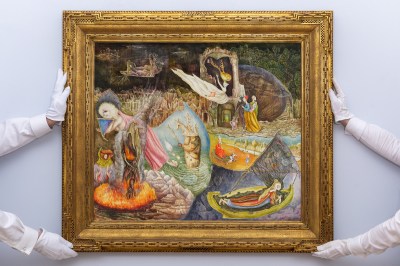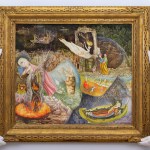After tepid sales results during the first two nights of the marquee art auctions in New York, Sotheby’s Modern evening sale netted $235 million, led by Claude Monet, Leonora Carrington, René Magritte, and Alexander Calder.
While 96 percent of lots sold and several bidding wars broke out, nervousness continued to be evident among buyers through the large number of incremental bids, 32 out of 50 works sold with guarantees and/or irrevocable bids, as well as several works by blue-chip artists that passed or sold well below estimates, including two by Pablo Picasso. Two oil paintings, Georges Braque’s Anvers, le mât (1906) and Sam Francis’ Yellow, Orange and Blue (1958), were also withdrawn prior to the auction.
The first bit of drama in the evening occurred when five bidders competed for Calder’s 5-foot-high, 25-foot-wide mobile Blue Moon (1962), which carried an estimate of $7 million to $10 million. After more than five minutes, Lot 3 sold for $12.2 million, or $14.4 million with fees, to a buyer in the room. Auctioneer Oliver Barker would later openly ask a former staffer in the audience, “Are you bidding or just pointing at the Calder?”
Later, three bidders on the phones chased after Claude Monet’s Meules à Giverny (1893) for even more time at eight minutes. The colorful Impressionist painting of haystacks would hammer at $29.8 million, or $34.8 million with fees, an amount that prompted cheers and applause. It went to a buyer on the line with Sotheby’s deputy chairman for Asia, Jen Hua, on an estimate “in excess of $30 million.” The auction house said after the sale the painting sold to a buyer in Asia.

Leonora Carrington’s Les Distractions de Dagobert (1945) sold for $28.5 million with fees, shattering the artist’s record.
Courtesy of Sotheby’s
Shortly afterwards, interest in Leonora Carrington’s Les Distractions de Dagobert (1945) proved to be even more competitive among six parties, including two in person.
The Surrealist painting featured behind Barker’s rostrum was already set to be a record-breaker with its estimate of $12 million to $18 million. But during the nearly ten-minute bidding war, Barker oversaw bids between senior vice president Alejandra Rossetti, Hua, and a person in the room, before the latter finally offered $24.5 million. Barker gave Rosetti and Hua time to counter-bid before raising his hammer, but there were no more new offers from the phones. “The gentleman has waited long enough,” Barker said.
That amount was finally enough to secure the Surrealist painting. At about $28.5 million with fees, Carrington’s previous auction record of $3.25 million set at Sotheby’s New York two years ago was obliterated and it even surpassed the auction records for fellow Surrealists Max Ernst ($24.4 million in 2022) and Salvador Dali ($21.7 million in 2011). And it turned out the purchase was three decades in the making.
After the sale, Sotheby’s identified the buyer as Top 200 collector Eduardo F. Costantini, an Argentinian developer, businessman and the founder of the Museum of Latin American Art in Buenos Aires.
“An iconic painting, The Distractions of Dagobert, is one the most admired works in the history of surrealism and an unparalleled masterpiece of Latin American art. I was the underbidder when she reached the artist’s record 30 years ago and tonight once again, we made a new auction record! This masterpiece will be part of a collection where amongst other two important works by Remedios Varo and another record breaking Frida Kahlo are also found,” Constantini said in a statement.
(When Sotheby’s sold Les Distractions de Dagobert to its anonymous consignor in 1995, it went for $475,000.)
After Monet and Carrington, René Magritte’s Le Banquet (circa 1955 to 1957) was the third highest lot of the night, selling for a hammer price of $15.5 million, or $18.1 million with fees, on an estimate of $15 million to $20 million. It also had a third-party guarantee.
Other lots which achieved eight figure sums were Monet’s Antibes vue de la Salis (1888) for $12 million hammer, $14.1 million with fees (estimate of $12 million to $18 million); Picasso’s Buste d’homme (1969) for a hammer price of $10.8 million, $12.7 million with fees (estimate of $8 million to $12 million); an untitled painting by Mark Rothko from 1969 which hammered at $9.5 million or $11.25 million with fees (estimate of $10 million to $15 million); as well as Édouard Manet’s Vase de fleurs, roses et lilas (1882) which sold for $10.1 million with fees (estimate of $7 million to $10 million).
Les Distractions de Dagobert wasn’t the only Surrealist work to get a bidding war. Varo’s Esquiador (Viajero) (1960) garnered bids for more than five minutes, including from Lulu R.C. de Creel, head of Sotheby’s Mexico. The work sold hammered for $3.4 million or about $4.2 million with fees, on an estimate of $1 million to $1.5 million. The auction house said Varo’s work went to a buyer in Asia.
Activity after the major Carrington sale was noticeably more subdued, with works like Picasso’s L’Enlèvement (1933) hammering at $600,000 or $762,000 with fees (estimate of $1.2 million to $1.8 million); Henry Moore’s Reclining Figure: Umbilicus getting a hammer price of $785,000 or just under $1 million with fees (estimate of $1.5 million to $2 million); and Vincent Van Gogh’s Tête de paysanne (1882) selling for a hammer of $620,000 or $787,400 with fees on an estimate of at least twice that at $1.5 million to $2.5 million.
Two works by blue-chip artists immediately prior to the van Gogh portrait would also fail to sell: Picasso’s Femme au chapeau (1941) (estimate of $6 million to $8 million), and the Henry Moore sculpture Working Model for Mother and Child: Block Seat (estimate of $1.2 million to $1.8 million).
One of the most notable declines in market value was seen in Hans Hofmann’s Lava (1960). The six-foot-tall oil-on-canvas painting sold at Christie’s for more than $8.8 million during a November evening sale in 2017, setting a record for the artist. The work was even featured on the cover of an exhibition catalogue for a survey at the Museum of Modern Art in 1963, and included in several retrospectives at the Tate, the Whitney, and the National Gallery in Washington. But, at Sotheby’s Thursday, Lava wasn’t that hot even with a third-party guarantee. It hammered at $3 million, or just under $3.7 million with fees on an estimate of $3 million to $5 million, going to a buyer on the phone with Sotheby’s Chairman of the Americas and former Guggenheim Museum director Lisa Dennison.
Near the end of the night was a reminder about how much one online bidder can mean amidst the ongoing website issues at Christie’s. Interest for Pierre Bonnard’s Nu s’habillant (1925) involved multiple Sotheby’s staffers on the phone which led to a back-and-forth between head of contemporary marquee private sales Charlotte van Dercook and an online bidder. After nearly three minutes, the online bidder with paddle number 25 would secure a hammer price of $2.5 million, or just over $3 million with fees, well above the estimate of $800,000 to $1.2 million.
“Thank you so much for your patience,” Barker said.
This post was originally published on this site be sure to check out more of their content






